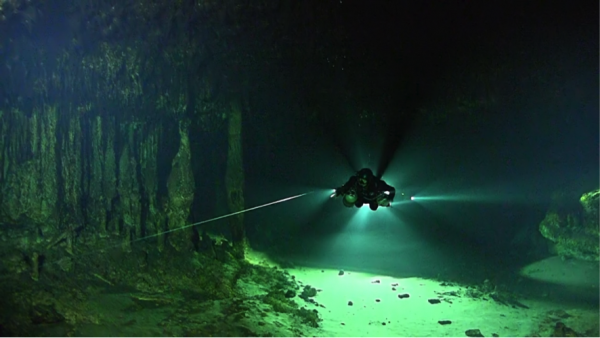Methane fuels Yucatan's extraordinary underworld
November 28, 2017
Sonnary Campbell
907-474-7811

Methane gas sustains an ecosystem deep within the flooded caves of Mexico’s Yucatan Peninsula, according to new research from a team that included University of Alaska Fairbanks scientists.
The scientists studied the Ox Bel Ha cave network of the northeastern Yucatan, a subterranean estuary filled with layers of fresh rainwater and salty ocean water. Methane forms naturally beneath the jungle floor and migrates downward into the cave water.
UAF researchers Mary Beth Leigh and Mary-Cathrine Leewis, of the Institute of Arctic Biology, detected methane-oxidizing bacteria among the cave system’s microbes. The bacteria form an important link in the ecosystem.
“Bacteria eat methane and other forms of carbon dissolved in water that percolates down into the caves from the soil, and then filter-feeding cave shrimp eat those bacteria, allowing the carbon to enter the food web,” Leigh said.
Prior studies assumed that microbes get most of their organic food from vegetation and other sediment that washes into the caves. However, little of that surface debris is present deep in the caves, where this study was conducted.
“Finding that methane and other forms of mostly invisible dissolved organic matter are the foundation of the food web in these caves explains why cave-adapted animals are able to thrive in the water column in a habitat without visible evidence of food,” said the paper’s lead author, David Brankovits of Texas A&M University at Galveston.
The research, conducted by scientists highly trained in cave diving, is the most detailed ecological study to date of a constantly submerged coastal cave ecosystem. The scientists used techniques developed for deep-sea vehicles.
The study is relevant to similar ecosystems worldwide, according to Tom Illiffe, a Texas A&M at Galveston marine biology professor who has studied marine cave animals for nearly 40 years.
“Providing a model for the basic function of this globally distributed ecosystem is an important contribution to coastal groundwater ecology and establishes a baseline for evaluating how sea level rise, seaside touristic development and other stressors will impact the viability of these lightless, food-poor systems,” Illiffe said.
The research was conducted during field expeditions funded by the U.S. Geological Survey, Texas A&M at Galveston and the National Autonomous University of Mexico. Field assistance came from Moody Gardens and Speleotech. Researchers from the USGS, UAF Institute of Arctic Biology, University of Basel Switzerland and Woods Hole Oceanographic Institution provided data on the collected materials. USGS involvement was partially supported by its gas hydrates and coastal aquifers projects.
CONTACTS: Mary Beth Leigh, University of Alaska Fairbanks, 907-474-6656, mbleigh@alaska.edu; David Brankovits, Texas A&M University of Galveston, 409-354-9893, david.brankovits@gmail.com


